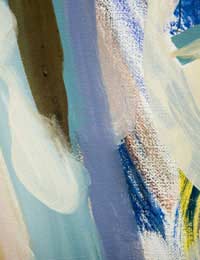Learning About Abstract Art

Abstraction came about in the early 20th Century (see related article: Abstraction) and is a term applied to artworks that are not directly related to natural or man-made forms. Abstract art expresses a vision of life that whilst being based on natural forms and human experience tries in no way to convey those experiences in a directly intelligible fashion.
In a sense abstract art can then be seen as a step on from expressionist art in that it is once more removed from a clear and accurate depiction of reality. However, the aim with abstract art is not to always express the emotions (although this is the case with the work of the ‘Abstract Expressionists’ such as Jackson Pollock: 1912-1956) but sometimes merely to convey ‘paint’ in its purest form, as a flat medium characterised by its propensity towards producing highly tonal and colourful artworks. This means that abstraction cannot be easily defined other than as an artwork that has no clear referential link to anything outside the artwork visible in its final outcome.
Approaching Abstract Art
Given the freedom that abstract art offers, one may be mistaken for thinking that there is something easy about producing an abstract drawing or painting. However, this is not the case and anyone who has been confronted between the choice of 100 different candy bars (for example) will know that far from making it easier to choose your ideal candy bar, the sheer choice actually makes it more difficult than if there were, say just three bars to choose from!With abstraction in the arts, the artist finds him/herself in a similar predicament with regard to having too many choices to make, except in this case there are many more choices to actually be made, and each one may impact on the other (as one colour, or tone, on the canvas affects the way the one next to it is received, and so on).
For this reason, the choice to make an abstract artwork can never be a flippant one and must be made only when other choices have been exhausted. For instance, one may wish to make an abstract artwork once they have reached the limits of what they may wish to achieve with colour when painting in a realistic manner. Or one may wish to turn to abstract expressionism when they find that a painting of a landscape or portrait is not adequate to them expressing the emotion that they wish to convey.
In either case it is useful to approach first the works of other Abstract artists in order to take note of the attention that they paid/pay to the formal elements of an artwork. In an Abstract painting or drawing you will notice that a harmonious link between the varying elements that make a painting is as necessary as in a landscape. It is worth considering your composition before you proceed with your art piece, although adjustments can be made along the way.
Essentially, as with any other drawing or painting, an abstract one should ultimately aim to achieve a balance of tone, colour and line across the canvas or paper.


Re: Contextualising Your Work
Dear Mr Watson, I have been working relentlessly for 40 years through Art, writing, performance based expressions in theatre, dance,…
Re: How to Sell My Paintings and Drawings?
Hi , I would like say about my cousin that he live in Afghanistan and he is fabulous in art painting and doing job…
Re: How to Sell My Paintings and Drawings?
Amy - Your Question:Hi I have just left school and I love to draw I do pencil work and I would love to sell my…
Re: How to Sell My Paintings and Drawings?
Hi I have just left school and I love to draw I do pencil work and I would love to sell my drawing but I don't no how…
Re: How to Sell My Paintings and Drawings?
Hi, I have 3 drawings the information as follows: 1- Salvador Dali (Spanish Draftsman). Is 24x19 cm. 2- Pablo…
Re: Freeing Yourself Up
I love drawing so much and I will like to be one of the best artist in the world
Re: How to Sell My Paintings and Drawings?
anna-81 - Your Question:Hi, I need help how can I sale my paintings and drawings and I want to know if my work is…
Re: How to Sell My Paintings and Drawings?
Hi, i need help how can i sale my paintings and drawings and i want to know if my work is really good or not. I'm…
Re: How to Sell My Paintings and Drawings?
i want to sell my drawing give me the idea.
Re: How to Sell My Paintings and Drawings?
I am 15 years old and i would like to sell my pencil drawing